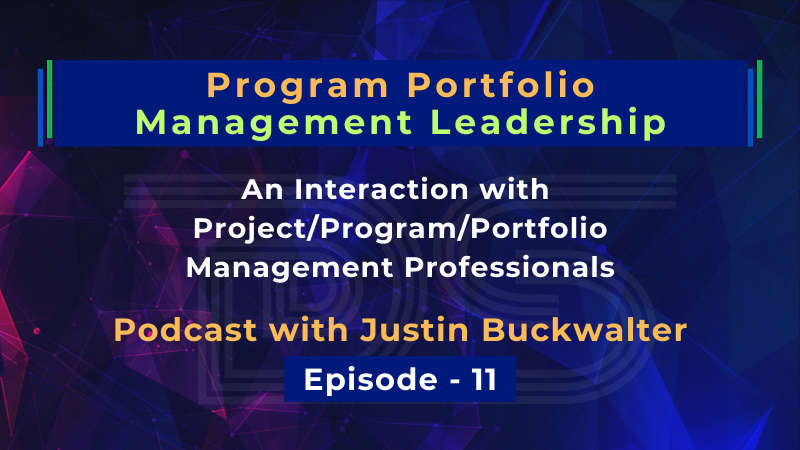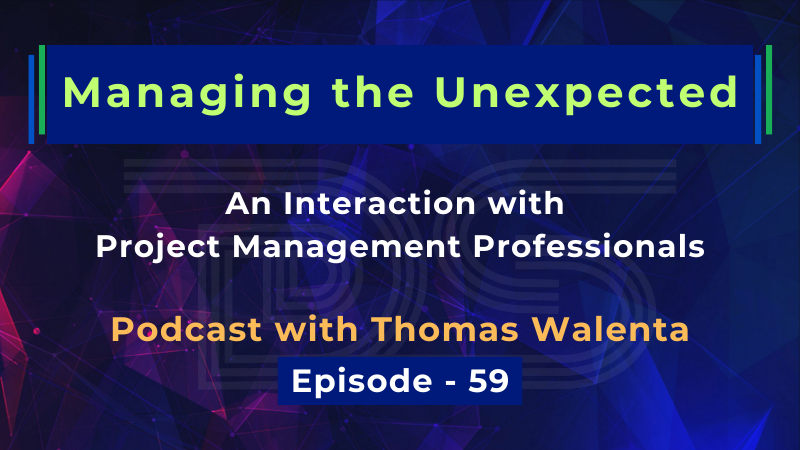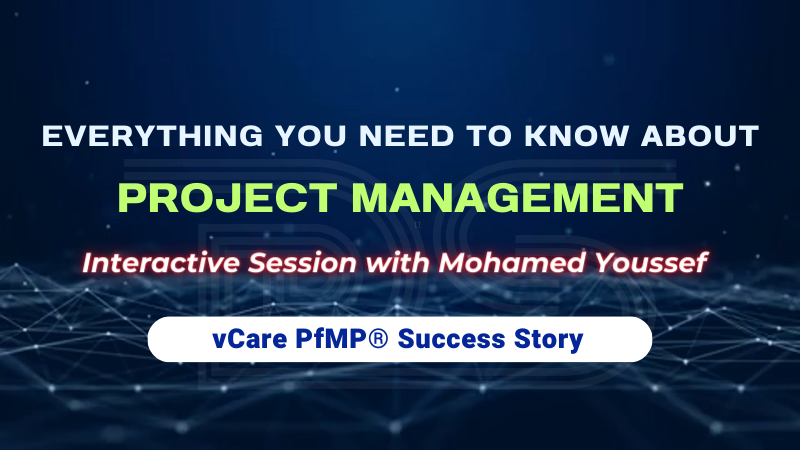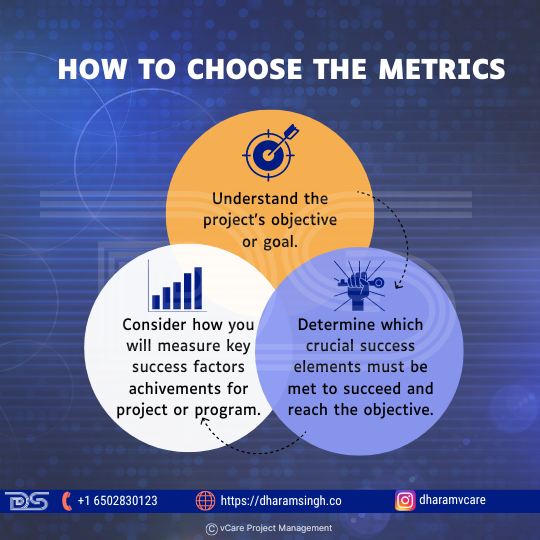
by DharamCW | Jan 21, 2024 | Program Management
Program Portfolio Management Leadership | Justin Buckwalter | Dharam Singh | Episode 11
Dive into the nuances of leadership with Justin Buckwalter, PfMP, PgMP, PMP, PMI-ACP, PMI-RMP and myself in the latest episode of our webinar series. We’re unraveling the facets of effective Program Portfolio Management Leadership, a skill set that’s becoming increasingly vital in the contemporary business landscape.
This episode is packed with insights on:
1. The diverse leadership styles that shape impactful leaders.
2. Emotional intelligence as a cornerstone for modern leadership.
3. Strategies for guiding teams through crises and organizational turbulence.
4. The dance between nurturing leadership and handling workplace politics.
5. Crafting meetings that matter with focused agendas and clear objectives.
Join us to understand why leadership in project management is more about EQ than IQ and how to foster strong team relations amidst complex challenges. Get ready to elevate your leadership approach for today’s dynamic world.
🎯 For Project Management professionals eager to elevate their careers, seize this chance:
– FREE webinar series on CAPM & PMP certifications: https://bit.ly/42iE5rJ
– Book an obligation-free 15-minute session with me: http://bit.ly/2SbhTOK
– Stay updated with our Q&A series and certification success stories by subscribing to the vCare Project Management YouTube channel at https://bit.ly/2YF0wJl
– Follow my podcasts and interviews with Project Management Experts on YouTube at https://bit.ly/2NDY8wd
– Avail Exclusive offers on our website: https://bit.ly/3jWVepD

by admin | Jan 19, 2024 | General
Project management is becoming an essential aspect all around the world. But, many businesses need help to complete projects successfully owing to a mismatch between business strategies and project management. They require assistance in determining the relationship between business strategies and project management. Alignment is essential to get a competitive edge and meet business objectives. Therefore, project management has grown its importance and is now critical in many firms.

Constraints Confront Projects
Projects are any temporary activity with a start, an endpoint, and specific performance objectives. Three constraints confront projects:
(1) Time
(2) Budget
(3) Performance
To achieve the organization’s goals, it is considered that the above three constraints need to be fulfilled. Therefore, project management is critical to attaining corporate objectives and is regarded as the organization’s backbone. And it is critical to achieving strategy, company goals, and intended outcomes.
Project Management
Project management uses specific knowledge, skills, tools, and techniques to deliver value to people. Project management has emerged as a critical concern for many worldwide businesses. Many project management implementations have been effective, while others have been deemed a failure. Projects are seen as the organization’s backbone, with success implying a great deal for an organization’s ability to compete. A project is described as a planned set of related tasks that must be completed within a specific time frame and particular costs and other constraints.

A Six-Step Technique That can be Useful in Avoiding the Worst Disasters in Project Management
A six-step technique that can be useful in avoiding the worst disasters in project management is:
Step 1: Determine the project’s scope.
Step 2: Establish the intended goal
Step 3: Describe each project component task.
Step 4: Determine the key players.
Step 5: Establish schedules for each project component.
Step 6: Evaluate, revise, and reallocate.
The successful beginning and execution of initiatives are largely dependent on strategy. Many businesses need help with misaligned projects and a systematic approach to aligning project management with business strategy. Organizations are better equipped to achieve their organizational goals by linking their initiatives to their business strategy. Project strategy should be linked to the project’s goals and objectives to achieve its desired competitive position.
Business Strategy
Business strategy is a complete collection of actions or activities that direct the use of a firm’s resources to achieve the vision and goals of the business and provide a long-term competitive advantage. Strategic management involves translating strategy into action to operationalize strategic objectives and gain a competitive advantage.
To ensure that strategies are translated into actions, they must be operational, which includes characteristics such as structuring an organization to support successful performance and enabling success through the way an organization’s various resource areas, such as people, information, Finance, IT, and so on, are managed. As a result, companies that implement their strategic plans may do better in sales growth, profits growth, deposit growth, return on assets, return on equity, return on sales, and return on total invested capital than those that do not.

Levels of Strategies are Offered by Different Levels of a Business
However, different levels of strategies are offered by different levels of a business in every organization, including:
- Corporate Planning:It requires a high degree of strategic decision-making to meet the stakeholders’ expectations.
- Strategy for Business Units:The goal of this strategy is to acquire a competitive edge for the services and goods provided, and choices at this level are focused on product selection, acquiring a competitive advantage, meeting consumer requirements, and creating new possibilities.
- Operational strategy:It is concerned with resource coordination and improvement, resulting in the effective and efficient implementation of the business unit-level strategy.
Strategy implementation requires taking activities and accomplishing tasks and should concentrate on how to materialize these strategies.
The following major points must be considered during implementation:
- Work execution necessitates distributing resources such as finances, people, and equipment. The organizational resources are limited.
- The implementation phase necessitates the creation of a project-supportive organizational structure.
- A project selection and prioritization framework guarantee a solid relationship between projects and the strategic strategy.
Managerial challenges include:
- Connecting project management with corporate strategy.
- Encouraging individuals to collaborate in developing new ideas.
- Renew existing strategies.
Aligning Business Strategy with Projects
Aligning the company’s projects to optimize their contributions to strategic goals necessitates a highly coordinated effort. Integration requires a strategy for selecting initiatives based on their value to the strategic plan. Organizations will need business and project management experts to collaborate to achieve business objectives to become more competitive, efficient, and lucrative. Both business and project management specialists will collaborate to connect initiatives with company objectives. The alignment of company strategy with project management is a fundamental problem for every organization.
Such alignments are challenging to achieve because business strategy objectives are only sometimes explicit, adequately articulated, or compatible with project management activities. Misalignment can lead an organization to fall short of its aims and objectives. Understanding the alignment may be one of the most challenging aspects of the project management process. Alignment is a process that requires dominating leadership, top management backing, effective communication, a collaborative work atmosphere, trust, correct prioritizing, technical setup, and a thorough understanding of the business’s operations. To obtain the intended outcomes from the selected projects, the company should be able to develop capabilities and then distribute those competencies to the recommended projects. To ensure that corporate projects are linked with corporate strategy, keep the following in mind:
- Is the company committed to strategic project management?Most businesses have hundreds of projects running at any given time; therefore, there must be a corporate commitment to the art and science of project management.
- Is there a policy in place for formally preparing project charters?Because projects are the methods through which corporate plans are implemented, they must adhere to the original business philosophy, strategy, and objective. Project charters are the tool for doing so.
- Is there collaboration between the business group and those in charge of project implementation?Early engagement of project implementation personnel is required. While this theory appears logical, putting it into practice is difficult. First, corporate planners may choose to prepare without the assistance of considered “outsiders.” Then there’s a good probability that the right individuals are doing something other than brainstorming and assessing the early stages of a business strategy.

Benefits of Aligning Business Strategy with Projects
Some benefits the organizations include:
- Saved money and resources
- Increased profitability
- Retained customers
- Increased market share
Prioritizing a project based on its contribution to strategy achievement does not ensure project success. Still, consistent resource allocation is also a big responsibility. Therefore, a significant point to ensure alignment between project management and strategy is as follows:
- To carry out the suitably chosen projects efficiently
- Companies must ensure that they can implement the projects and programs.
Therefore, the alignment of projects is strongly influenced by top management.
Why Should Project Managers Care About Business Strategy?
A project manager must be able to connect their project within the larger context of the company to be truly effective. Understanding the basic business strategy is critical to achieving a great outcome. Strategic alignment and delivery should be wider than senior-level executives because the outcomes influence everyone in the business. On the other hand, a project manager should be wholly involved in all aspects of the project, including understanding and being concerned about business strategy.

Why Should Project Managers Care About Business Strategy?
Although it may appear counterproductive to focus on larger goals rather than the project itself, there are many significant reasons why project managers should be concerned with business strategy:
- Boosts Team Morale
A team will follow the project manager’s instructions. Connecting your project to a larger company goal offers everyone a feeling of purpose and connectivity. It helps people realize they are contributing to a more significant cause rather than just completing the work. It enhances team morale in this setting because it offers employees a feeling of purpose.
Furthermore, when individuals believe there is a greater good at risk, persuading them to pivot on a project is simpler. Finally, when teams can see the larger picture, they can better recognize when there is a break in activity or when resources need to be reallocated.
- Establishes Stakeholder Support
Understanding executive jargon provides you greater leverage when requesting and securing stakeholder support. A project manager will gain more cooperation if they can explain to senior team members how their participation will benefit the organization. Understanding the company’s strategy enables a project manager to structure requests in ways that are more likely to receive approval and favorable feedback. If a project manager can instill value in their team members and senior stakeholders, the odds of project success increase significantly—the greater the level of support, the more likely a favorable result.
- Outputs and Outcomes
Business strategy is about taking a step back and looking at the big picture. The traditional approach to project management held that the end of a project was about output, and what someone did with that data was their responsibility. Modern project management requires a professional to analyze the overall company strategy and what will happen with the project’s output when it goes out of your hands. It’s about remaining business-aware throughout the project so that the company’s best interests can always guide it. This awareness is how great employee morale and stakeholder support are achieved. Today’s most effective project managers can relate project outputs to successful corporate outcomes.
Final Thoughts
A good project manager should be familiar enough with their company’s strategy to utilize it to increase team morale and create a broader picture for their team. Once the team is on board, the same interactions may be used to obtain stakeholder support. Finally, the ability to link output to outcomes will guarantee that the project is successful at every step. Project managers and business leaders must formally understand how to establish, explain, and maintain strategic focus. This view will give project execution a new dimension and bring project management closer to being a competitive weapon for organizations. Choosing the right strategic focus at the start of a project and making it consistent with the company plan can help the project succeed and lead to better business results.
Projects offer an excellent opportunity to obtain a competitive advantage and bring value to the firm. Strategic project management is thus essential. Therefore, one of the most critical parts of project strategy is having a sufficient strategic focus.
Lastly, an understanding of business strategy makes for a well-rounded project manager.
Feel free to check out my discussion on this topic with Thomas Walenta in YouTube
For any questions related to your Project Management career, training, and certifications, you can book an obligation free 15 minutes session with me by visiting https://bit.ly/2SbhTOK
You can subscribe to the vCare Project Management YouTube Channel to catch future videos of our Q&A series and certification success stories: https://bit.ly/2YF0wJl
You can subscribe to and follow my podcasts and interviews with Project Management Experts on YouTube at https://bit.ly/2NDY8wd

by DharamCW | Jan 13, 2024 | Project Management
Managing the Unexpected | Project Management | Thomas Walenta | Dharam Singh | Episode 59
In the face of uncertainty, exemplary project management is about planning and adapting. Join Thomas Walenta and me in a critical discussion on “Managing the Unexpected” in project environments.
We uncover:
✨ Strategies for becoming a “Highly Reliable Organization” (HRO)
✨ The art of navigating supply shortages and leading transformation amidst chaos
✨ Building robust crisis models for the modern landscape
✨ Identifying opportunities when projects veer into the unknown
Episode 59 is a treasure trove of wisdom for senior project, program, and portfolio managers seeking to steer their teams with resilience and foresight.
Don’t let unpredictability unsettle your projects. Arm yourself with the insights to manage risks and champion change.
Prepare to transform challenges into success stories.
🎯 For Project Management professionals eager to elevate their careers, seize this chance:
– Book an obligation-free 15-minute session with me: http://bit.ly/2SbhTOK
– Stay updated with our Q&A series and certification success stories by subscribing to the vCare Project Management YouTube channel at https://bit.ly/2YF0wJl
– Follow my podcasts and interviews with Project Management Experts on YouTube at https://bit.ly/2NDY8wd
– Avail Exclusive offers on our website: https://bit.ly/3jWVepD

by DharamCW | Jan 11, 2024 | Professional Development Webinars
Free Webinar: Everything You Need to Know About Project Management
Mark your calendars for Jan 18, 2024! I am thrilled to host an insightful session with Mohamed Youssef ,B.Eng,MBA , PfMP®,PgMP®, PMP®, RMP®, CCCM, MEP Operation Manager at Electro Mechanical Engineering Co., Doha, Qatar and a recent PfMP® certificant, bringing over two decades of expertise to the table. It’s a unique opportunity to gain valuable career insights and understand the nuances of the PfMP® certification.
Gain 1 PDU and enrich your project management toolkit as we explore:
✅ Showcasing your organizational contributions through meticulous project tracking.
✅ Mastering contingencies with best practices in project management.
✅ Steering stakeholder expectations alongside time plan adjustments.
✅ The art of inspirational leadership for team growth.
✅ The power of active listening in bolstering team dynamics for project triumph.
This session is crafted for project management professionals poised to lead with agility and strategic foresight. Embrace this chance to refine your leadership understanding and drive project excellence.
🔗 Don’t miss out; reserve your spot now: https://bit.ly/4aLdJmP
Session Time: 08:30 AM – 09:30 AM (PST) / 09:30 AM – 10:30 AM (MST) / 10:30 AM – 11:30 AM (CST) / 11:30 AM – 12:30 PM (EST) / 01:30 PM – 02:30 PM (BRT) / 04:30 PM – 05:30 PM (GMT) / 05:30 PM – 06:30 PM (CET) / 07:30 PM – 08:30 PM (AST) / 08:30 PM – 09:30 PM (GST) / 10:00 PM – 11:00 PM (IST)
Whether you’re tuning in from PST or IST, we’ve covered you with a global timetable. Let’s shape the future of project management together! Let’s transform challenges into opportunities together!
Elevate Your Project Management Career:
– Discover training offers and certification discounts: https://bit.ly/3jWVepD
– Book an obligation-free consultation session on PM Career, training, and certifications: http://bit.ly/2SbhTOK
– Stay updated: Subscribe to our YouTube Channels for more insights: https://bit.ly/2YF0wJl and expert interviews: https://bit.ly/2NDY8wd

by DharamCW | Jan 9, 2024 | Project Management
🎯 Setting the Right Course with Metrics: A Guide for Success 🎯
In the intricate dance of project management, selecting the right metrics is akin to setting the compass for a voyage. I want to share a straightforward approach to pinpointing the metrics that resonate with your project’s true north.
1️⃣ Start With Clarity: Begin by crystallizing the project’s goals. What are we aiming to achieve?
2️⃣ Identify Key Success Elements: What milestones must we reach that spell success?
3️⃣ Measurement Matters: Devise a strategy to gauge each achievement. How will we know we’ve arrived?

How to choose the metrics
Adhering to these steps can navigate your project through the murky waters of uncertainty toward the lighthouse of success. Metrics are more than numbers; they’re the heartbeat of progress, the rhythm of innovation, and the pulse of accomplishment.
Dive into aligning your project’s compass with the right metrics. Your journey toward project mastery is just a measurement away.
Elevate Your Project Management Career:
– Please register for my FREE webinar series on PgMP® and PfMP® certifications: https://bit.ly/3Z7kzMl
– Discover training offers and certification discounts: https://bit.ly/3jWVepD
– Book an obligation-free consultation session on PM Career, training, and certifications: http://bit.ly/2SbhTOK
– Stay updated: Subscribe to our YouTube Channels for more insights: https://bit.ly/2YF0wJl and expert interviews: https://bit.ly/2NDY8wd
















Recent Comments